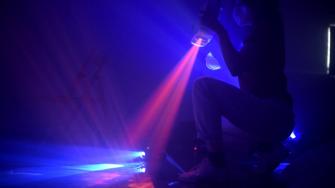Aftermath
Residency at Fleetstreet Theater Hamburg
Exposure to catastrophes or cataclysms is universal, yet they are experienced by and large individually and highly subjectively. Since the start of the pandemic and during the course of the following years, and in the face of human-made ecological catastrophes, the feeling of living in a permanent “aftermath” is something we have collectively come to live with. The notion that successive catastrophes and cataclysms keep accumulating inspired our concept of living in a permanent aftermath as a modus operandi.


A team of artists explored this topic during a residency at Fleetstreet Theater Hamburg in February 2024. The project created a space in which the audience is invited to confront some of the existential questions related to this feeling of standing amidst the ruins and the rubble of a bygone disaster and surrender to something new - in all its beauty and all its darkness. The project team consist of Edyta Jarzab, sound artist, Martha Szymkowiak, stage designer, Lukas Ishar, video artist and Josefine Simonsen, dancer and Alina Sobotta, performer/director whom we interviewed on their approach:
What did you do during your Residency at the Fleetstreet Theater in Hamburg?
We transformed Fleetstreet into a hybrid rehearsal studio: Air travel and a plane-crash were a point of departure for a guided journey with ambiguous destinations: death and the question of what lies beyond what we can rationally grasp. So the room featured a swing made from airplane seats, tacky paradise-posters and lots of clouds/fog. We worked with projections and soundscapes heavily, in order to evoke a floaty atmosphere of timelessness and disorientation.
Your aim was to create a collective realm, in which thoughts about a permanent aftermath can be confronted and feelings embraced. What were your experiences with the audience and the reactions?
We worked on the project in three sessions over two years – during our first showing in Hamburg, we were surprised at how much information our dense atmosphere conveyed. Some audience members were entirely new to the concept and “intuitively” understood our story-arch: that you are a passenger on a plane which crashed, and memories or the airport and flight keep bubbling up, together with disturbances, irritations, blood and finally dissolution into light. Their feelings were melancholy, gory, but also excitement for the form we started developing.


You were in exchange with several CAPAS fellows and other researchers about their work and their perspectives on aftermaths and apocalypses. What did you take away from that?
First of all: many thanks go out to Alexander-Kenneth Nagel (University of Göttingen), Gerriet Schwen (University of Hannover) and Katie Barclay (University of Adelaide). From these conversations we took away new, academically grounded perspectives and also a more fitting vocabulary on our subject – from the tradition of apocalyptic writings, metaphysical discourse on apocalypse/end/transformation, as well as current crises. We are grateful to our conversation-partners for taking the time to share their work and also to shed some light on what we were actually working on.
What differences and what similarities, what mutual benefits did you experience in the project combining artistic and scientific perspectives?
We noticed that we had started our artistic research heavily based on creative intuition – we started creating atmospheres with our means: beamers, fog machines, synthesizers, choreography. We searched to evoke this “flow” where our impulses are in sync and take us somewhere new. Talking to academics working on the subject of apocalypse/post-catastrophe/multiple crisis-scenarios, was immensely enlightening. Their thoughts and perspectives helped structure and rationalize our more diffuse artistic approach. Thank you!